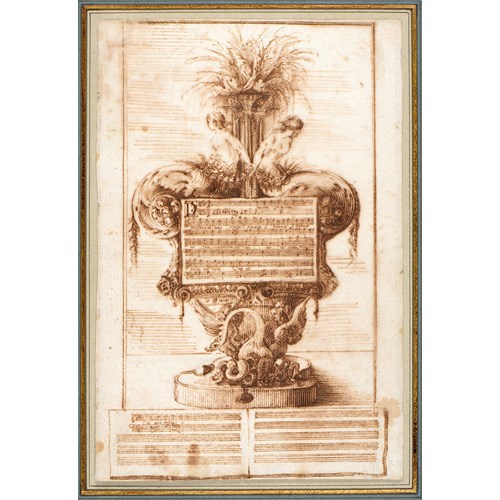Jacques LE MOYNE DES MORGUES
A Globe Artichoke (Cynara scolymus)
Period 16th cnetury
Origin London
Medium Watercolour and gouache on paper prepared as vellum, with framing lines in brown ink and watercolour.
Dimension 19.5 x 14.7 cm (7⁵/₈ x 5³/₄ inches)
Perhaps the earliest, and certainly the most substantial, album of botanical studies by Le Moyne to have come to light, the ‘Du Marry’ album contains eighty drawings in watercolour and gouache, together with an elaborate frontispiece in the form of an architectural cartouche, below which is written, in a 16th century hand, ‘Cela est donné par Du Marry’, signed with the initial H(?) below. The drawings from this album may date to the mid to late 1560s, when Le Moyne was still working in France, and as such are probably earlier in date than those found in the albums in the Victoria and Albert Museum and the British Museum. While several of the plants depicted in the ‘Du Marry’ album also appear in the other known albums, Le Moyne was careful to make each watercolour composition different from others of the same species. Characterized by elegant compositions enclosed in fictive frames, the watercolours in the ‘Du Marry’ album are drawn on paper smoothed with a stone to achieve a vellum-like surface. The paper is almost identical to that found in the Victoria and Albert florilegium, which is closest to the ‘Du Marry’ album in conception, appearance and date.
Le Moyne’s ‘Du Marry’ album is one of the earliest French florilegia known. A compendium of images of flowering plants, studied directly from nature, a florilegium was related to the herbal; an early form of plant book providing exacting descriptions of plants for medicinal purposes. The rise of exploration in the 16th century brought many new plants to Europe, and stimulated a concurrent interest in garden design. There was also much demand, among collectors and scholars of exotic plants, for artists to record their transient beauty. Le Moyne was among the leading 16th century artists who specialized in the production of elaborately painted florilegia, and his splendid work in this field found a particularly receptive audience in Elizabethan England.
As the scholar Paul Hulton has noted of Le Moyne’s watercolours in the British Museum album, in terms equally applicable to the present sheet, ‘The drawings are nearly all of plants then commonly found in French or English gardens…They show an exquisite attention to detail, yet are drawn with a deep understanding and love of the subject which avoids all traces of superficial prettiness. They are plant portraits which delight the eye and at the same time satisfy to a remarkable extent the scientific requirements of the botanist. The combination of these virtues is very rarely found to the same degree at this period.’
A domesticated variety of the wild cardoon (Cynara cardunculus), the artichoke began to be cultivated in southern France and Italy in the late 15th and early 16th centuries. The plant was introduced into England in the first quarter of the 16th century, and by 1530 artichokes were being grown at King Henry VIII’s garden at New Hall in Essex.
A similar study of a globe artichoke is part of the album of watercolours by Le Moyne in the collection of the Victoria and Albert Museum in London. An artichoke is also found among the woodcuts of the Le clef des champs, pour trouver plusieurs animaux, tant bestes qu’oyseaux, avec plusieurs fleurs et fruitz, published by the artist in London in 1586.
Jacques Le Moyne de Morgues, as one modern scholar has written, may be regarded as ‘one of the earliest and most gifted botanical painters…His surviving watercolours and miniatures…show a surprising naturalism and a highly refined sense of colour and form.’
Period: 16th cnetury
Origin: London
Medium: Watercolour and gouache on paper prepared as vellum, with framing lines in brown ink and watercolour.
Dimension: 19.5 x 14.7 cm (7⁵/₈ x 5³/₄ inches)
Provenance: Part of an album belonging to 'Du Marry' (according to an inscription on the frontispiece of the album)
Anonymous sale, New York, Sotheby’s, 26 January 2005, part of lot 46 (the album sold for $1,136,000)
W. Graham Arader, New York.
More artworks from the Gallery


_T637329168399625082.jpg?width=2000&height=2000&mode=max&scale=both&qlt=90)






_T638548371546897304.jpg?width=500&height=500&mode=pad&scale=both&qlt=90&format=jpg)